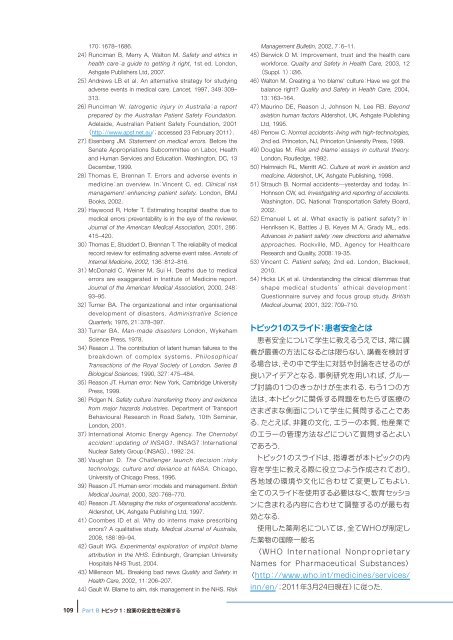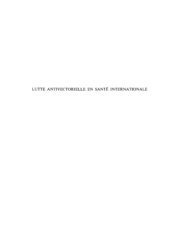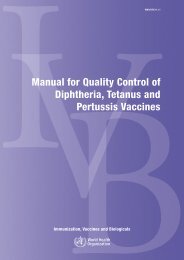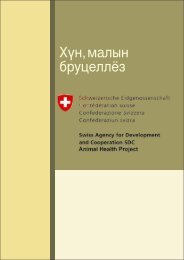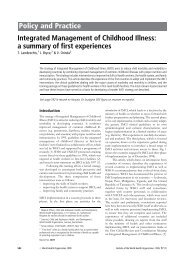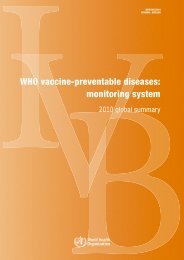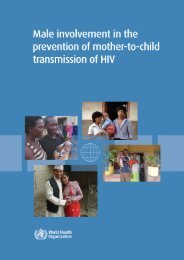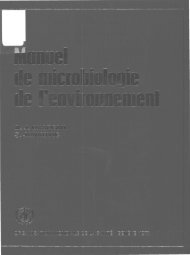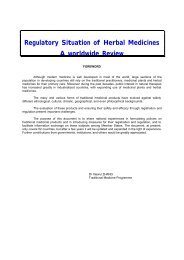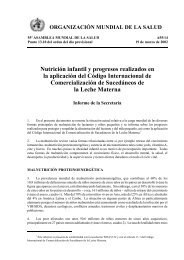WHO Patient Safety Curriculum Guide - Extranet Systems - World ...
WHO Patient Safety Curriculum Guide - Extranet Systems - World ...
WHO Patient Safety Curriculum Guide - Extranet Systems - World ...
Create successful ePaper yourself
Turn your PDF publications into a flip-book with our unique Google optimized e-Paper software.
1701678–1686.<br />
24Runciman B, Merry A, Walton M. <strong>Safety</strong> and ethics in<br />
health carea guide to getting it right, 1st ed. London,<br />
Ashgate Publishers Ltd, 2007.<br />
25Andrews LB et al. An alternative strategy for studying<br />
adverse events in medical care. Lancet, 1997, 349309–<br />
313.<br />
26Runciman W. Iatrogenic injury in Australiaa report<br />
prepared by the Australian <strong>Patient</strong> <strong>Safety</strong> Foundation.<br />
Adelaide, Australian <strong>Patient</strong> <strong>Safety</strong> Foundation, 2001<br />
http//www.apsf.net.au/accessed 23 February 2011.<br />
27Eisenberg JM. Statement on medical errors. Before the<br />
Senate Appropriations Subcommittee on Labor, Health<br />
and Human Services and Education. Washington, DC, 13<br />
December, 1999.<br />
28Thomas E, Brennan T. Errors and adverse events in<br />
medicinean overview. InVincent C, ed. Clinical risk<br />
managementenhancing patient safety. London, BMJ<br />
Books, 2002.<br />
29Haywood R, Hofer T. Estimating hospital deaths due to<br />
medical errorspreventability is in the eye of the reviewer.<br />
Journal of the American Medical Association, 2001, 286<br />
415–420.<br />
30Thomas E, Studdert D, Brennan T. The reliability of medical<br />
record review for estimating adverse event rates. Annals of<br />
Internal Medicine, 2002, 136812–816.<br />
31McDonald C, Weiner M, Sui H. Deaths due to medical<br />
errors are exaggerated in Institute of Medicine report.<br />
Journal of the American Medical Association, 2000, 248<br />
93–95.<br />
32Turner BA. The organizational and inter organisational<br />
development of disasters. Administrative Science<br />
Quarterly, 1976, 21378–397.<br />
33Turner BA. Man-made disasters London, Wykeham<br />
Science Press, 1978.<br />
34Reason J. The contribution of latent human failures to the<br />
breakdown of complex systems. Philosophical<br />
Transactions of the Royal Society of London. Series B<br />
Biological Sciences, 1990, 327475–484.<br />
35Reason JT. Human error. New York, Cambridge University<br />
Press, 1999.<br />
36Pidgen N. <strong>Safety</strong> culturetransferring theory and evidence<br />
from major hazards industries. Department of Transport<br />
Behavioural Research in Road <strong>Safety</strong>, 10th Seminar,<br />
London, 2001.<br />
37International Atomic Energy Agency. The Chernobyl<br />
accidentupdating of INSAG1. INSAG7International<br />
Nuclear <strong>Safety</strong> GroupINSAG, 199224.<br />
38Vaughan D. The Challenger launch decisionrisky<br />
technology, culture and deviance at NASA. Chicago,<br />
University of Chicago Press, 1996.<br />
39Reason JT. Human errormodels and management. British<br />
Medical Journal, 2000, 320768–770.<br />
40Reason JT. Managing the risks of organisational accidents.<br />
Aldershot, UK, Ashgate Publishing Ltd, 1997.<br />
41Coombes ID et al. Why do interns make prescribing<br />
errors A qualitative study. Medical Journal of Australia,<br />
2008, 18889–94.<br />
42Gault WG. Experimental exploration of implicit blame<br />
attribution in the NHS. Edinburgh, Grampian University<br />
Hospitals NHS Trust, 2004.<br />
43Millenson ML. Breaking bad news Quality and <strong>Safety</strong> in<br />
Health Care, 2002, 11206–207.<br />
44Gault W. Blame to aim, risk management in the NHS. Risk<br />
Management Bulletin, 2002, 76–11.<br />
45Berwick D M. Improvement, trust and the health care<br />
workforce. Quality and <strong>Safety</strong> in Health Care, 2003, 12<br />
Suppl. 1i2i6.<br />
46Walton M. Creating a 'no blame' cultureHave we got the<br />
balance right Quality and <strong>Safety</strong> in Health Care, 2004,<br />
13163–164.<br />
47Maurino DE, Reason J, Johnson N, Lee RB. Beyond<br />
aviation human factors Aldershot, UK, Ashgate Publishing<br />
Ltd, 1995.<br />
48Perrow C. Normal accidentsliving with high-technologies,<br />
2nd ed. Princeton, NJ, Princeton University Press, 1999.<br />
49Douglas M. Risk and blameessays in cultural theory.<br />
London, Routledge, 1992.<br />
50Helmreich RL, Merritt AC. Culture at work in aviation and<br />
medicine. Aldershot, UK, Ashgate Publishing, 1998.<br />
51Strauch B. Normal accidentsyesterday and today. In<br />
Hohnson CW, ed. Investigating and reporting of accidents.<br />
Washington, DC, National Transportation <strong>Safety</strong> Board,<br />
2002.<br />
52Emanuel L et al. What exactly is patient safety In<br />
Henriksen K, Battles J B, Keyes M A, Grady ML, eds.<br />
Advances in patient safetynew directions and alternative<br />
approaches. Rockville, MD, Agency for Healthcare<br />
Research and Quality, 200819-35.<br />
53Vincent C. <strong>Patient</strong> safety, 2nd ed. London, Blackwell,<br />
2010.<br />
54Hicks LK et al. Understanding the clinical dilemmas that<br />
shape medical students ethical development<br />
Questionnaire survey and focus group study. British<br />
Medical Journal, 2001, 322709–710.<br />
トピック1のスライド: 患 者 安 全 とは<br />
患 者 安 全 について 学 生 に 教 えるうえでは, 常 に 講<br />
義 が 最 善 の 方 法 になるとは 限 らない. 講 義 を 検 討 す<br />
る 場 合 は,その 中 で 学 生 に 対 話 や 討 論 をさせるのが<br />
良 いアイデアとなる. 事 例 研 究 を 用 いれば,グルー<br />
プ 討 論 の1つのきっかけが 生 まれる.もう1つの 方<br />
法 は, 本 トピックに 関 係 する 問 題 をもたらす 医 療 の<br />
さまざまな 側 面 について 学 生 に 質 問 することであ<br />
る.たとえば, 非 難 の 文 化 ,エラーの 本 質 , 他 産 業 で<br />
のエラーの 管 理 方 法 などについて 質 問 するとよい<br />
であろう.<br />
トピック1のスライドは, 指 導 者 が 本 トピックの 内<br />
容 を 学 生 に 教 える 際 に 役 立 つよう 作 成 されており,<br />
各 地 域 の 環 境 や 文 化 に 合 わせて 変 更 してもよい.<br />
全 てのスライドを 使 用 する 必 要 はなく, 教 育 セッショ<br />
ンに 含 まれる 内 容 に 合 わせて 調 整 するのが 最 も 有<br />
効 となる.<br />
使 用 した 薬 剤 名 については, 全 て<strong>WHO</strong>が 制 定 し<br />
た 薬 物 の 国 際 一 般 名<br />
(<strong>WHO</strong> International Nonproprietary<br />
Names for Pharmaceutical Substances)<br />
(http://www.who.int/medicines/services/<br />
inn/en/;2011 年 3 月 24 日 現 在 )に 従 った.<br />
109 Part B トピック 1: 投 薬 の 安 全 性 を 改 善 する


